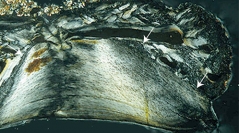

 Comptes Rendus Palevol
18 (7) - Pages 783-799
Comptes Rendus Palevol
18 (7) - Pages 783-799Bone microanatomy appears strongly linked with the ecology of organisms. In amniotes, bone mass increase is a microanatomical specialization often encountered in aquatic taxa performing long dives at shallow depths. Although previous work highlighted the rather generalist inner structure of the vertebrae in snakes utilising different habitats, microanatomical specializations may be expected in aquatic snakes specialised for a single environment. The present description of the vertebral microanatomy of various extinct aquatic snakes belonging to the Nigerophiidae, Palaeophiidae, and Russelophiidae enables to widen the diversity of patterns of vertebral inner structure in aquatic snakes. A large-scale comparative analysis with extant snakes, including numerous semi-aquatic and aquatic forms, and additional extinct taxa, highlights that, even for snakes specialised for a single environment, vertebral microanatomy does not correlate well with the ecology. Thus, it cannot be used as a proxy for ecological inferences in snakes. In addition, the study emphasizes the strong difficulty in characterizing “osteosclerosis” in snake vertebrae. Finally, it points out and discusses the peculiarity of the marine hind-limbed snakes, the only snakes showing pachyosteosclerosis.
Snake, vertebra, microanatomy, aquatic lifestyle, osteosclerosis, Pachyophiids